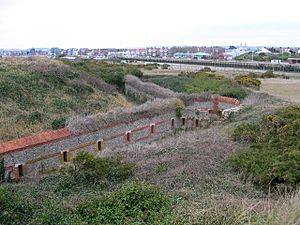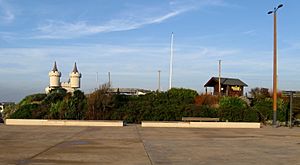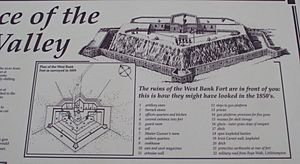Littlehampton Redoubt facts for kids
Littlehampton Fort, also known as Littlehampton Redoubt, was built in 1854. It stands on the south coast of England, near the mouth of the River Arun in Littlehampton. Its main job was to protect the area from a possible attack by the French, led by Emperor Napoleon III. Before this, there was an older battery on the east side of the river. But the new fort was built on the west side.
The fort had a special platform for cannons. These cannons could fire across the harbour mouth. Behind them were barracks for soldiers. A defensive ditch and wall surrounded the whole fort. Littlehampton Fort was a very modern military building for its time. It even had a new feature called a Carnot wall. The fort was only actively used for about 20 years. This was because weapons technology changed very quickly. Today, Littlehampton Fort is mostly a ruin, covered in ivy. But it is still an important historical site.
Contents
Earlier Defenses
People thought about building a defense on the east side of the River Arun in Littlehampton around 1587. But there is no proof it was ever built. Later, in the early 1700s, there was a small battery with five guns.
In 1756, the Seven Years' War with France began. People worried about a French invasion. So, in 1760, a battery was built on the east bank of the river. It had seven guns that could cover the river mouth and the seafront. Part of this old defense can still be seen today. It is now part of the amusement park called Harbour Park.
Why a New Fort Was Needed
In the 1840s, many people and politicians wanted better defenses for England's south coast. They were worried about a French attack. In 1846, the Duke of Wellington, a famous general, wrote a public letter. He said he was very concerned about the lack of defenses.
Another important person, Sir John Burgoyne, also wrote a paper in 1846. He agreed with the Duke of Wellington. This paper was shared with Wellington, who wrote back agreeing with everything. Wellington's letter was then leaked to the newspapers. It caused a big public alarm in 1848. This led to Parliament voting for more money for the navy and army. People were also worried about the plans of Emperor Napoleon III between 1852 and 1853.
Because of these worries, the Board of Ordnance decided to build a new fort at Littlehampton. Historians say that the War Office was concerned. They thought if Littlehampton and Shoreham ports were captured, the enemy could use them. This would help them bring in more troops to attack Portsmouth from behind. Then they could march on London.
Planning for the new fort began in the early 1850s. It was built on the west bank of the river. The work finished in September 1854. It cost £7,615. Captain Fenwick of the Royal Engineers oversaw the building. A large London company called Locke and Nesham did most of the construction. They had built other public buildings before. A local company also helped build the glacis, which is a sloping bank of earth.
What the 1854 Fort Looked Like
The new fort was shaped like a lunette. This is a straight-sided crescent shape. The fort had a platform for its guns. This platform was surrounded by a wide ditch, about nine yards (eight meters) wide. In the middle of this ditch was a Carnot wall. This wall was designed to stop attackers trying to cross the ditch. The wall had small holes for defenders to shoot through.
At each corner of the fort were open bastions. These were projecting parts where soldiers could fire at attackers along the wall. Behind the gun platform was a strong barrack block for soldiers. This fort was the first of its kind in the United Kingdom. Its Carnot wall and three open bastions made it very unique.
Later, another barrack block was built outside the fort. This was for more troops. In 1861, about 70 men lived at the fort. This included gunners, a surgeon, officers, and soldiers. The fort's weapons were brought by sea. They included three large 68-pounder cannons and two smaller 32-pounder cannons.
Later Life of the Fort
In 1873, a report on Coast Defenses found that Littlehampton Fort was not good enough anymore. It only had old-fashioned smooth bore guns. Also, it was not strongly built. It had open bastions and no casemates, which are protected rooms for guns. It also had no iron-cladding. The report suggested upgrading the fort. But this upgrade never happened.
The guns were finally removed in 1891. Parts of the fort were taken apart.
Today, the site is fenced off. You can view it from a wooden walkway over the sand dunes. A notice board with a diagram explains what you can see of the fort. This includes the surrounding ditch, one of the bastions, part of the Carnot wall, and the ramparts behind.





